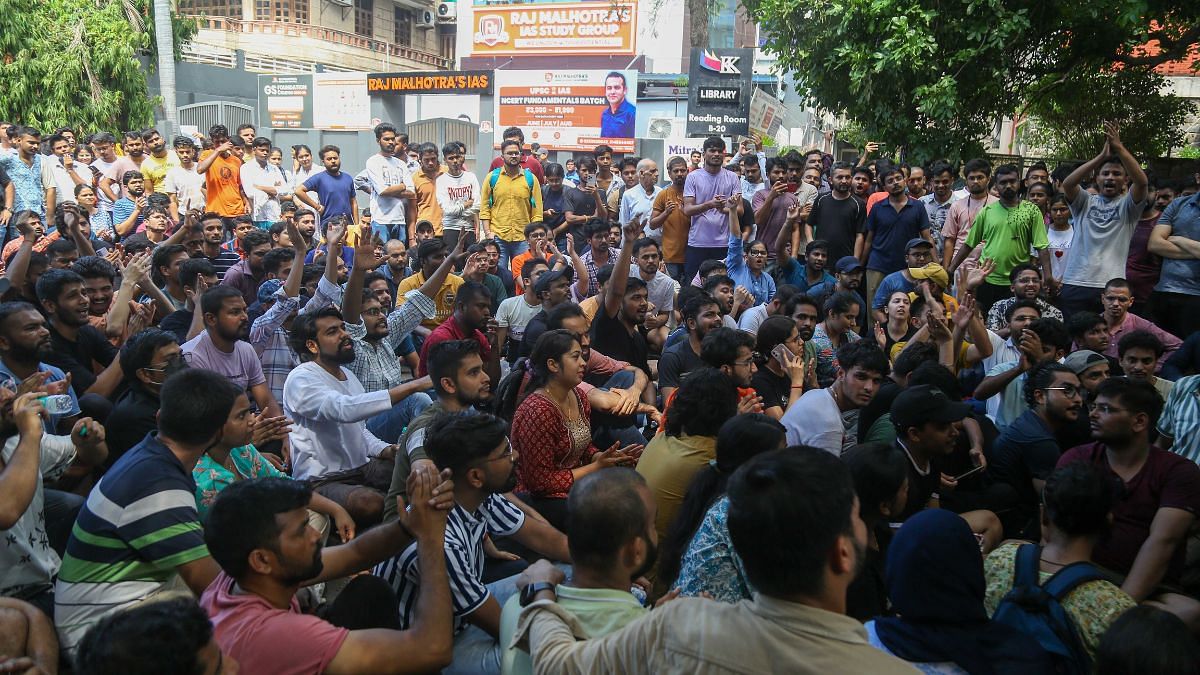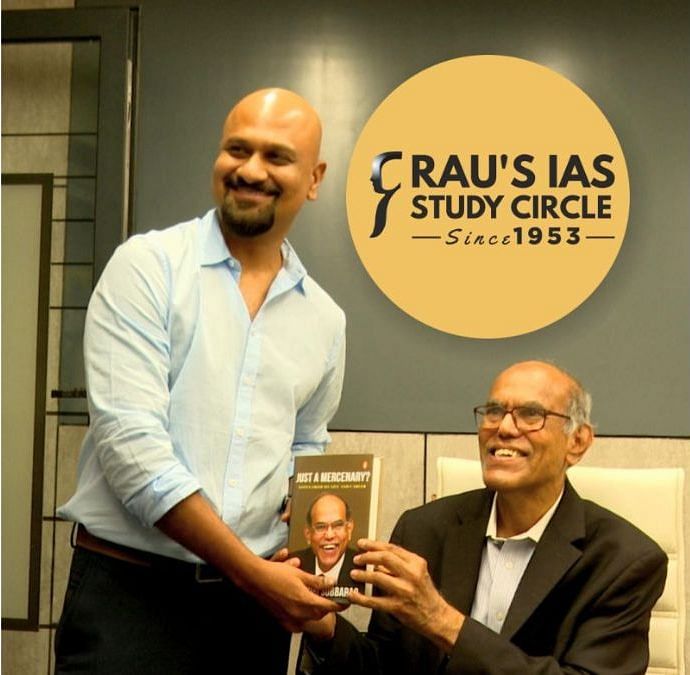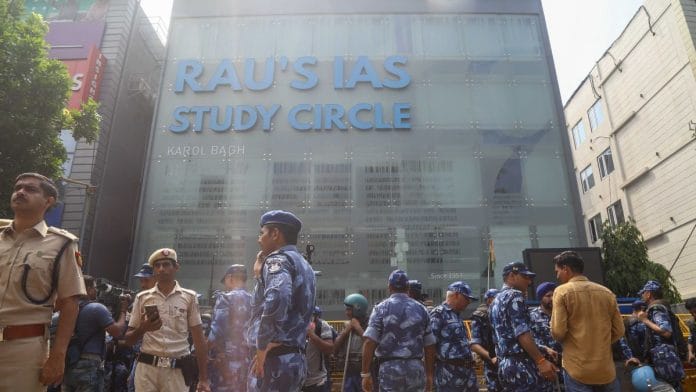New Delhi: Rau’s IAS Study Circle started in 1953 in a small room at the Hotel Palace Heights, in Delhi’s Connaught Place.
A group of students gathered in a big circle around Dr S Rau, the namesake founder of the coaching institute, to learn political science. He turned out to be so good at it that he began coaching students formally year after year, preparing them for what was known then as the Indian Administrative Service Exam.
The tradition of a small circle of students being personally guided by one teacher has continued at Rau’s, which has now scaled up to be one of the most well-known coaching institutes in India with branches in Delhi and Bengaluru. And while three students losing their lives in the flooded basement of the institute’s new building in Old Rajinder Nagar has brought Rau’s IAS under the scanner for unsafe infrastructure, it’s long been in the sights of IAS aspirants across generations.
“It is generally said that the industry in Delhi is established primarily by Rau’s—it’s the oldest coaching institute as far as we know,” said Vijender Singh Chauhan, an industry expert who trains students in giving UPSC interviews and teaches at Delhi University. “It’s true that it’s always focused on student-centric coaching with small batches of students. In recent years, it’s begun to expand to look at mass clientele.”
The basement library at Rau’s IAS Study Circle that became a death trap for three IAS aspirants only opened in August 2023—at the students’ behest.

The three students who drowned on 27 July—Nevin Dalvin, Tanya Soni, and Shreya Yadav—were among many others who had gathered to study that weekend, choosing to be at Rau’s IAS library because it was free for them. It’s part of the ‘package’ that Rau’s IAS offers its students, along with classroom teaching and personalised mentorship.
The coaching centre, which had a change in leadership in 2010 to better transition into the digital age, has been undergoing a rebrand of sorts in an attempt to keep up with stiff competition from other newer and nimble coaching centres. It plateaued in the early 2000s, according to insiders, and business began to pick up a decade ago in 2014.
In the last year, Rau’s IAS was hugely successful: 281 of its students cleared the UPSC in April 2024. Nine of the top 20 students were from Rau’s including the topper.
Rau’s IAS is a popular choice amongst older civil servants, as it was one of the few formal institutes around while they were studying.
“Awareness around Rau’s depends on the background of the student,” said Chauhan. “Usually students whose parents are from the civil services have heard of it, as well as English-medium students and students from a science or medical background.”
On 25 May 2024, Rau’s took out a full front page ad in The Hindu celebrating 70 years of being in the business. And while it was headquartered at the same place in Barakhamba Road for most of these 70 years, it recently opened a new centre in Old Rajinder Nagar.
The building is reportedly rented by Rau’s, and the building owners had it built to their specifications.
“It’s a fairly complex problem in the trifecta of Karol Bagh, Rajinder Nagar, Patel Nagar. Landlords are obnoxious with tenants, brokers are shady, food is adulterated, water is dirty, open wires are everywhere, manholes and sewage overflow. There are clashes with local residents. Rents have skyrocketed. Students live congested, difficult lives,” said Atish Mathur, a freelance UPSC teacher and a lawyer who takes up UPSC cases pro bono.
He’s one of the many who said the incident at Rau’s—even if it goes by the guiding principle of quality of education over quantity of students—points to a deeper structural problem across all coaching institutes.
“If greed had a face, it would be Rajinder Nagar,” said Mathur. “The education one would receive at Rau’s versus anywhere else is virtually indistinguishable. There’s nothing called exclusivity in UPSC coaching. If they have fewer students, it’s because there are fewer students joining. Rau’s, like every other UPSC coaching institute that has sidelined students’ interests, has been on the decline for a long time.”
Also read: UPSC aspirants’ desperation & the coaching mafia exploitation. ‘No one sees us as human’
‘It feels like family’
Rau’s IAS is not just the oldest in the business, it’s also the point of origin for other coaching centres.
In 1976, one of Dr Rau’s associates Professor P Velayutham left to set up Vajiram & Rao—now Vajiram and Ravi, another major institute with centres in Delhi and Chennai. In 1986, an associate of Dr Rau, VP Gupta, took over the management of Rau’s and began to herald a new age. His son-in-law, Abhishek Gupta, has been CEO since 2010, qualifying Rau’s as a family business of sorts.
“Rau’s is not just an institute to me. It’s a family for me.”
“Dr Rau’s guiding principle to teaching was a low student-to-teacher ratio to allow personalised attention for each student—to encourage students to question the facts/theories rather than just accepting them,” wrote Rau’s IAS in a written response to ThePrint in December 2023. “Throughout a journey lasting over seven decades, the Study Circle has been at the cutting edge of real learning by delivering education in a personalised way or the boutique approach as Mr VP Gupta likes to put it.”
It’s certainly a sentiment that faculty members share.
“Rau’s is not just an institute to me. It’s a family for me,” said one faculty member, who’s been teaching at Rau’s since 2018 and requested not to be named. “I’m working at Rau’s IAS not for the money, but because I feel it’s my family.”
Students agree that this personalised approach—with added mentorship—is one of the main draws of Rau’s as a coaching institute in a crowded, hyper-competitive industry.
“I chose Rau’s because of the quality of its faculty, and I feel the accessibility of the faculty is something different,” said 24-year-old Kingsley Kannan, a UPSC aspirant from Tamil Nadu who is currently enrolled at Rau’s. “Around six months after coming to Rau’s, I realised that all coaching institutes are more or less the same—everything depends on the individual’s efforts. And faculty at Rau’s have some time to personally help individual students if they reach out.”
With around 35-40 teachers split across their Delhi and Bengaluru centres, the institute still focuses on teaching offline batches of only 100 students—as opposed to other major coaching centres that have much larger batches. It charges roughly the same as other coaching institutes—Rs. 1.75 lakh for two years. Over the last 20 years, it has expanded to accommodate up to 5,000 students in 50 batches of 100, according to Rau’s response to ThePrint in 2023.
And the fraternity acutely feels the loss of the three students who drowned in the institute’s library. One faculty member remembers questions that his favourite student Dalvin asked him as “bright, sharp, and insightful” and said that he and other faculty members remember the names of each and every student owing to small batch sizes. Kannan used to sit parallel to Dalvin in the library. Other students remember exchanging smiles on staircases with Soni, and exchanging handwritten notes with Yadav.
“Nevin was one of my favourite students. It was a pleasure to work with him and learn from the doubts he asked me,” said a faculty member. “They were all bright students. There are no words to express the loss we’re feeling with their deaths.”
A modern CEO
Exactly a month before the incident, now-arrested CEO Abhishek Gupta was celebrating a completely different milestone.
“27 June 2024 was a day to remember at Rau’s IAS Study Circle! We had the incredible honour of welcoming back Duvvuri Subbarao sir, former Governor of the RBI, to his alma mater after 50 years,” he posted on LinkedIn. “Subbarao sir, who topped the UPSC IAS Exam in 1972, shared his nostalgic journey of preparing for the AS exam at the very first classroom of Rau’s IAS Study Circle at Hotel Palace Heights.”
This legacy began to fade as other players entered the market, overtaking Rau’s in the 2000s.
VP Gupta is known for setting Rau’s culture in stone, and not budging from his commitment to quality over quantity—even if it puts profit on the backburner.
Then Abhishek Gupta entered the picture in 2010. Described by employees as a “modern-day CEO” who “doesn’t want to be seen as one”, Gupta encouraged a transparent, informal workplace—anyone could walk into his cabin at any time and for any reason.

“He runs the show from behind, and he’s very happy with that,” said a faculty member, who added that he allows all employees to work with autonomy to encourage productivity.
Gupta took the reins from his father-in-law VP Gupta, who was at the helm of Rau’s for over 20 years.
“We are the pioneers in the field of coaching for the civil services. Anybody who has come into the field has to refer to our work, our notes and the content developed by us. Other coaching centres have to refer to the standards set by Rau’s. Most of them [the teachers] are ex-students or ex-faculty members of Rau’s, and that has become a qualification for teaching in this field. Rau’s is the touchstone for quality, and our teaching methodology has become the benchmark,” said VP Gupta in a 2012 interview. “We may be nearly 60 years old but at heart, we are still 16.”
VP Gupta is known for setting Rau’s culture in stone, and not budging from his commitment to quality over quantity—even if it puts profit on the backburner. He also founded a digital platform called Basm-e-Khas for music enthusiasts to come together and showcase Hindustani classical music.
This culture was updated by his son-in-law and moulded to fit the digital age. As part of this digital push, Rau’s IAS launched a free digital platform called Compass in June 2023—a digital library of sorts marketed as the ‘ultimate resource hub’ for UPSC aspirants.
“We are not really bothered by what the rest of the companies are doing in terms of marketing tactics, sales, new offers, etc; we are in a focused way working on the quality of knowledge and its delivery to our students in a personalised way,” wrote Rau’s IAS to ThePrint in December 2023.
A new building for a new start
“Rau’s has remained conventional, but the education sector has changed drastically, and so it had to evolve to changing times.”
In Delhi, the classification of coaching centres as elite and exclusive has to do with its geographic location. Karol Bagh is considered elite because it teaches in English, while Mukherjee Nagar caters to Hindi-medium aspirants. The practice of having libraries to study in is also recent, according to Chauhan—higher rents in places like Rajinder Nagar mean students have to live further away, and so libraries to study in are a luxury. Coaching centres now offer access to libraries as part of their ‘package.’
IAS aspirant Kannan says libraries charge anywhere between Rs 2,500 and Rs 3,000 a month for a reserved seat, and around Rs 1,500 for a floating seat. It’s why students approached Rau’s to set up its own library in the new building.
“Rau’s has remained conventional, but the education sector has changed drastically, and so it had to evolve to changing times. So we began to develop a digital footprint,” said a faculty member at Rau’s. “And this was a new building to reflect that.”
The library was operating illegally from its basement. And contrary to news reports, faculty members and employees insist that it didn’t have a biometric system that would lock students out. Students who were present in the building when it began to flood say the basement had two exits—they conducted rescue operations themselves from one end, while they believe Dalvin, Soni and Yadav were stuck at the front entrance of the library, by its shattered glass door.
“It’s a tragedy beyond comprehension,” said Kannan, who was one of the students who managed to escape the library on that fateful evening. “We couldn’t find them. How can a person stay underwater in dirty gutter water for two hours?”
Kannan doesn’t hold Rau’s IAS responsible. His anger is reserved for the Municipal Corporation of Delhi and the police, who arrived late to the scene and were ill-equipped to rescue students from the waterlogged basement.
To him, the institute was responding to its students’ needs—and the library was a case in point.
“By law, we can see it’s illegal. But the students only asked for it, that’s why the test series class was turned into a library. Nobody expected it would go like this,” he said.
Note: An earlier version of this story stated that the Rau’s IAS Study Circle building in Old Rajinder Nagar was owned by the company. This has been updated.
(Edited by Theres Sudeep)







Raus ias was (HEAVELY) fined by CCI which was even covered by print,.. for advertising interview guidance program students as students of Rau’s ias(charged at zero)… FALSE MARKETING..
There are 5 to 6 institutes in delhi coaching industry just focuses on mock interviews. And uploading them youtube after the final result. Rau’s ias is one of them, To garner attention and admissions.. sometimes student join a institute bcoz of faculty too. A year back post prelims polity teacher Saurabh sir has joined raus ias closing his institute, those students who joined year long test series in the previous institute of his were given access to test series in rau’s ias.
Esp Rau’s ias isn’t elite at all.. may be its old one in orn.
Can please explain when did the flooding start and why are the students trapped. No student would sit a library to study if they notice flooding esp if u are staying orn..
If institute management has noticed it , they would alarmed the students. I’m sure it’s normalcy of flooded basement. That’s why the laxicity.
Except athish matur sir whomever as teachers were cited in this article arent good at teaching. They are only good on youtube.
Modern CEO.. my foot.. If modern u mean referring to millennium(2000’s).. approachable boss and teacher , open offices are new Management style..
There are teachers who picks up the calls from the students at 11.00 PM..